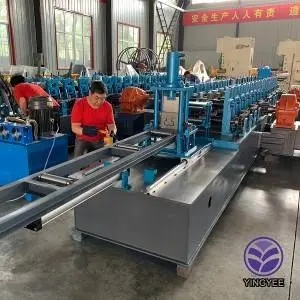
Multi-Axle Fender Cold Bending Machine A Technological Breakthrough in Automotive Manufacturing
In the ever-evolving world of automotive manufacturing, precision and efficiency are paramount. One of the latest innovations making waves in the industry is the Multi-Axle Fender Cold Bending Machine. This machine has revolutionized the way fenders are manufactured, catering to the increasing demand for high-quality automotive parts while ensuring cost-effectiveness and time efficiency in the production process.
Understanding the Mechanism
The Multi-Axle Fender Cold Bending Machine operates on a sophisticated mechanism designed for bending metal sheets into intricate shapes that are required for modern vehicle fenders. Unlike traditional metal bending processes that often involve heating the metal, this machine utilizes cold bending techniques. This not only reduces energy consumption but also minimizes the risk of altering the intrinsic properties of the metal, ensuring that the final product retains its strength and durability.
The machine features multiple axes of movement, allowing for a range of bending angles and shapes. This flexibility is crucial in automotive manufacturing, where fender designs vary significantly across different vehicle models. By employing a multi-axle system, manufacturers can create complex geometries with precision, which enhances the overall aesthetic and aerodynamic performance of vehicles.
Benefits of Cold Bending
Cold bending technology offers several advantages over conventional hot bending methods. One of the most significant benefits is the reduction in energy costs. Since the process does not require high temperatures, it conserves energy, making it an environmentally friendly option. Additionally, cold bending leads to less material waste, as precise cuts and bends can be achieved, further contributing to sustainable manufacturing practices.
Another advantage is the quality and finish of the final product. Cold bending reduces the likelihood of warping and distortion that can occur with heated processes. Consequently, the fenders produced are more uniform and exhibit better surface finishes, which are vital for aesthetic appeal in modern automobiles.

Impact on Production Efficiency
The introduction of the Multi-Axle Fender Cold Bending Machine has a significant impact on production efficiency. The automation capabilities of this machine streamline the manufacturing process, allowing for faster turnaround times without compromising quality. As a result, automotive manufacturers can meet tight deadlines and increase their output to satisfy the high demand for vehicles.
Moreover, this machine reduces the need for extensive manual labor, as its automated features facilitate easy operation. Operators can program the machine to execute precise bending tasks with minimal intervention, which not only saves time but also reduces the risk of human error.
Future Prospects
As the automotive industry trends towards more complex designs and sustainable practices, the role of advanced machinery like the Multi-Axle Fender Cold Bending Machine is bound to grow. Manufacturers are increasingly recognizing the importance of investing in technology that enhances productivity while adhering to environmental standards.
Moreover, with the rise of electric vehicles (EVs) and alternative fuel vehicles, the demand for innovative and lightweight materials is ever-increasing. The Multi-Axle Fender Cold Bending Machine is well-equipped to handle new materials that manufacturers might choose to adopt in their designs, further solidifying its place in the future of automotive manufacturing.
Conclusion
The Multi-Axle Fender Cold Bending Machine symbolizes a significant leap forward in automotive part fabrication. Its ability to produce high-quality, complex fender shapes with efficiency and sustainability sets a new standard in the industry. As automotive manufacturers continue to seek ways to innovate and maintain competitiveness, embracing advanced technology such as cold bending machines will be essential for achieving success in today’s fast-paced market. The future of vehicle manufacturing looks promising, and the advancements in machinery will undoubtedly play a pivotal role in shaping it.